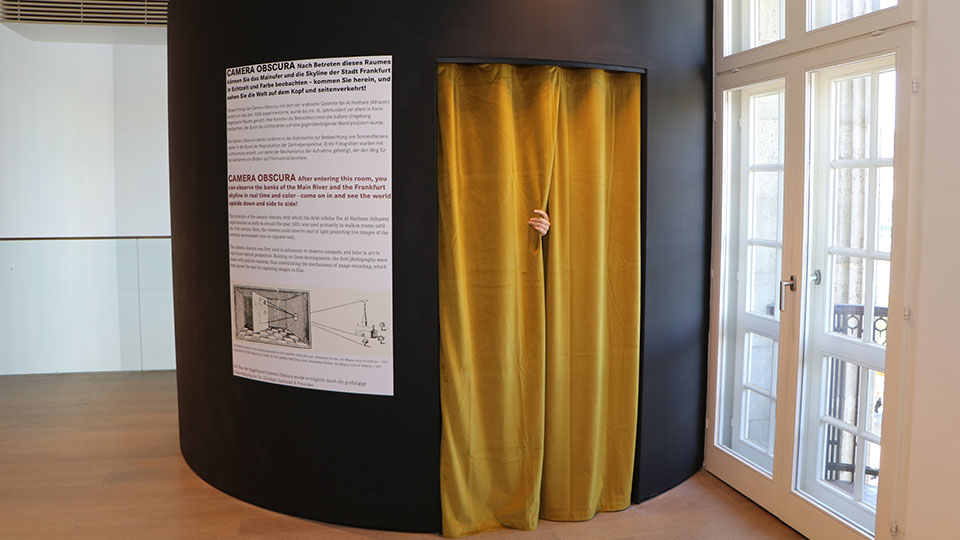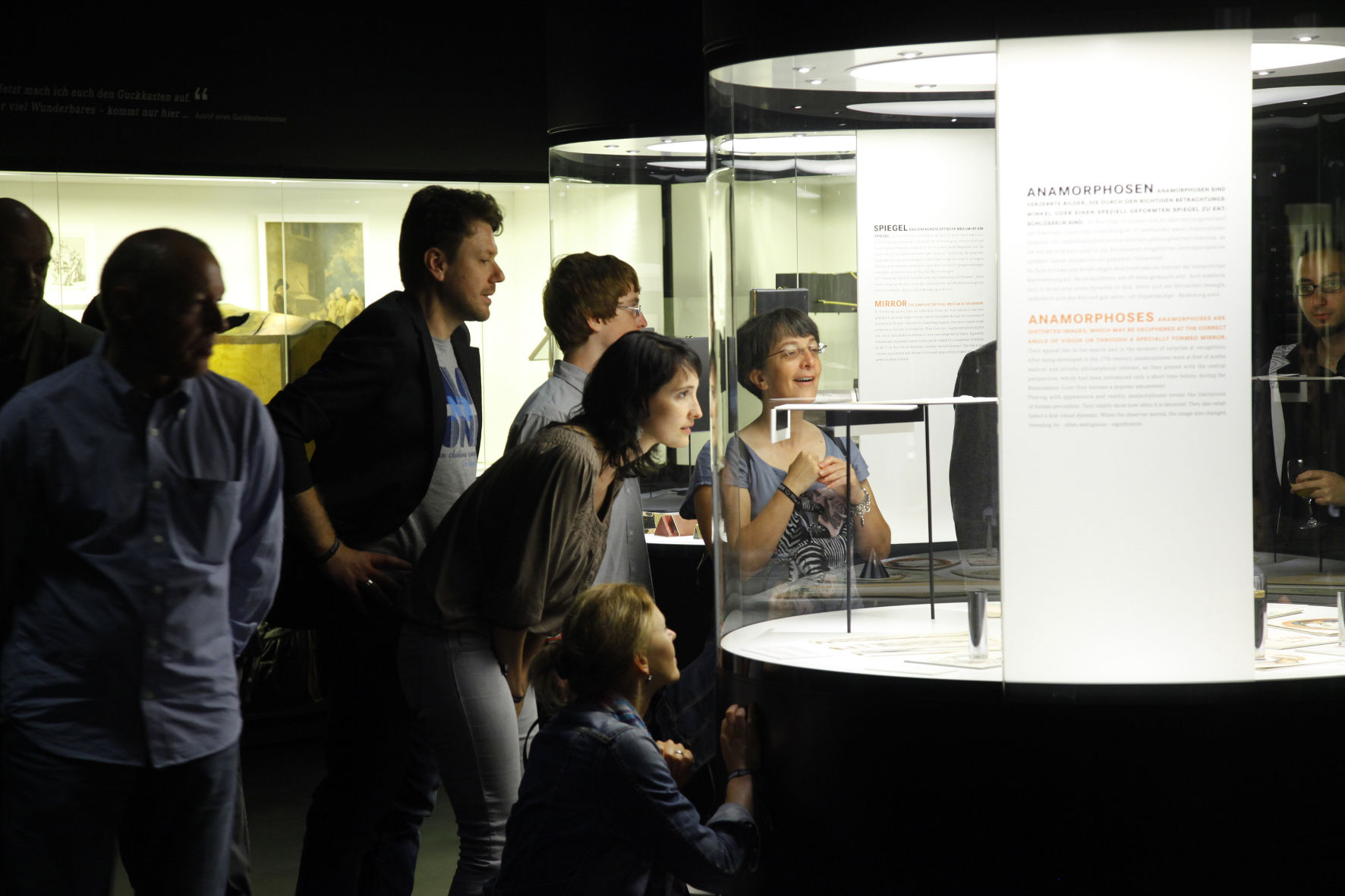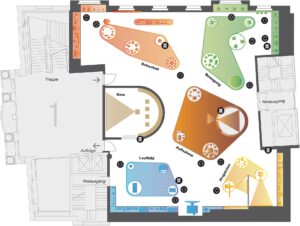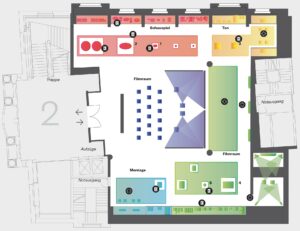On two floors, the permanent exhibition presents exciting exhibits, working models of historic devices and interactive stations. Large film projections invite visitors to explore moving images and experience the fascination of the medium of film.
Over the next two years, our permanent exhibition will be undergoing a series of renovations and upgrades. Stay tuned here for updates.
Camera Obscura
In 2022, we re-positioned our Camera Obscura so that it overlooks the Main River and the Skyline.

Cinematic Perception
The first part of the permanent exhibition, located on the second floor of the Museum, focuses on the diverse visual media of the 18th and 19th centuries and the invention of film. On the basis of the prehistory and early history of film, the question of how cinematic perception works and from which traditions it derives is explained. The exhibition is organized around the themes of curiosity, movement, recording, projection, the moving image and cinema.
Curiosity
This section presents historical apparatuses that play with the pleasures and deceptions of viewing, such as peep-boxes, anamorphoses, and kaleidoscopes. Visitors are invited to use models to understand how these devices work: Mirrors are used to decipher the distorted images of anamorphoses. A peek into the peep-box reveals how transparent images are transformed and how a night view is created from a day view by cleverly directing the light.
Movement
Long before the advent of movies, the phenakistiscope, the zoetrope, and the flip book were used to create moving images. In the exhibition, these devices are used to explain how humans perceive continuous motion when viewing still images. Visitors can experience these marvelous inventions first hand.
Recording
The Camera Obscura is considered to be the first device that allowed us to create an image of reality. From there, with the invention of photography, it was then finally possible to fix an image permanently.
Projection
The focus here is on the creation of images from light and the magic lantern as the most important projection medium of the 18th and 19th centuries. Highlights of this part of the permanent exhibition include a restored, over 200-year-old hand-painted lantern and a digital projection of historic lantern images. We invite visitors to become projectionists themselves!
Moving Image
We focus on the last years before the advent of film, introducing you to the various inventors such as Etienne-Jules Marey or the Lumière brothers and their experiments in creating moving images. The original Cinématographe Lumière is accompanied by a replica, which will allow visitors to appreciate the ingenuity of this first working film projector.
Cinema
The highlight and conclusion of the first part of the permanent exhibition is a small cinema that showcases the inventiveness and visual diversity of early film in two short programs. In addition to well-known classics such as the films of the Lumière brothers, the exhibition also includes rarities and curiosities from the archives that are rarely shown to the public, among them the first film ever made in Frankfurt am Main.
Cinematic Storytelling
This section of the exhibition, located on the 2nd floor of the museum, is dedicated to the principles and means of cinematic storytelling, based on the following themes: Image, Sound, Montage and Acting. The core message is that the impact of a movie depends not only on what it shows, but also on how it shows it.
The Film Room
The centerpiece of the second floor is the Film Room, a film installation which presents a collage of film clips on four large screens. The installation demonstrates the diversity of cinematic means of expression, makes them tangible to the senses, and sets an emotional mood for the content of the exhibition.
Image
Find out how camera angles and lighting control the narrative, and how film architecture and special effects make fictional locations seem real. See, for example, Wolfgang Petersen’s camera for The Boot (DE 1981) and a set design for Gone WithThe Wind (USA 1939, R: Victor Fleming). Experience various moods in our lighting studio or wander through fictitious worlds in the green screen corridor.
Sound
Learn how music can draw your attention to a scene or give you a sense of place, how music can comment on the action of a film, and how music can create emotional impact. Besides the original Tin Drum from Volker Schlöndorff’s film of the same name (DE 1979), we show a score from METROPOLIS (DE 1927, directed by Fritz Lang). Experiment with interactive media stations: Experience for example how the effect of film scenes changes when you set them to different music.
Montage
Here visitors will find the original storyboard of the famous shower scene from PSYCHO (USA 1960, R: Alfred Hitchcock). It shows how editing can be used to create an image that’s never explicitly shown. The essential role of montage in cinematic storytelling can also be explored hands-on, for example by changing the order of shots in a scene.
Acting
The focus here is on costume and makeup, as well as facial expressions, gestures, and body language as important levels of effect in cinematic storytelling. How strongly clothing shapes a character is shown by juxtaposing Romy Schneider in LUDWIG II. (IT/FR/DE 1972, directed by Luchino Visconti) with a stunt costume from ALIEN (USA/GB 1979, directed by Ridley Scott). Signed star postcards illustrate that an actor’s public perception depends not only on roles, but also on image.




